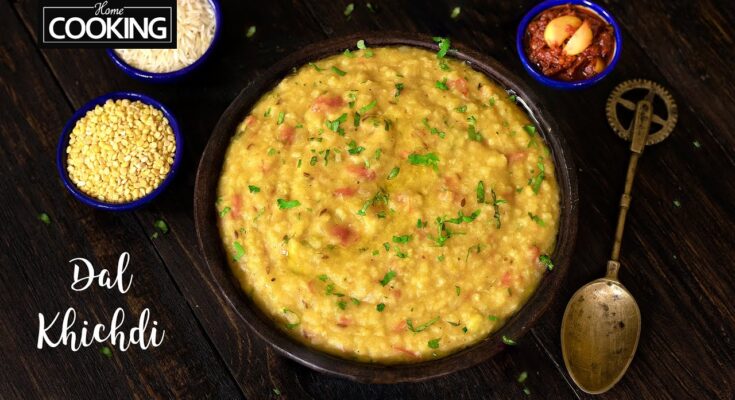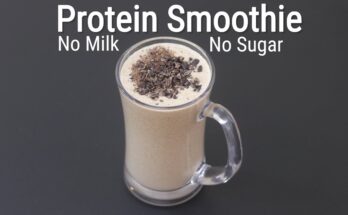Khichdi Recipe: Khichdi is more than just a dish—it’s comfort in a bowl. This simple yet hearty Indian meal is made by combining rice and lentils, often with a mix of vegetables and spices. It’s the go-to meal for sick days, lazy evenings, and even festival fasting. Why? Because it’s incredibly easy to make, gentle on the stomach, and still surprisingly satisfying. It’s one of those dishes that has a strong emotional connection in every Indian household—it’s warm, soothing, and feels like a warm hug from your grandma.
Originating from ancient Ayurvedic texts, Khichdi is considered a Tridoshic food, meaning it’s suitable for all body types. That’s not just cool—it’s also a huge reason why Khichdi has stood the test of time in Indian cuisine. You can make it plain with just rice and lentils or jazz it up with vegetables and ghee. Either way, it’s a wholesome, one-pot meal.
Importance of Khichdi in Indian Cuisine
Khichdi holds a sacred spot in Indian kitchens. It’s not only a staple in homes but also features in religious fasting and festive rituals. In fact, in some Indian regions, Khichdi is the first solid food given to babies. That’s how trusted and nourishing it is. It’s gluten-free, protein-rich (thanks to the lentils), and incredibly easy to digest.
In modern times, Khichdi has evolved from just a “sick day” food to a gourmet dish. You’ll now find Khichdi being reimagined in five-star hotels, cooked with exotic vegetables, and even served with truffle oil. But at its core, it remains a symbol of simplicity and nourishment.
Ingredients Needed for Khichdi
Basic Ingredients
To make a classic Khichdi, you don’t need fancy ingredients. Here’s what you’ll typically use:
- Rice – Short-grain varieties like Sona Masoori work best.
- Moong Dal (Yellow Split Lentils) – Easy to digest and quick to cook.
- Water – For soaking and cooking.
- Ghee (Clarified Butter) – Adds a rich flavor and aroma.
- Cumin Seeds (Jeera) – For tempering.
- Hing (Asafoetida) – Helps with digestion.
- Turmeric Powder – Gives it that beautiful golden hue.
- Salt – As per taste.
These ingredients are likely already in your kitchen if you cook Indian food often. They form the foundation of the dish, giving it the flavor and texture that’s both comforting and delicious.
Optional Add-ons for Flavor and Nutrition
Want to make your Khichdi a bit more exciting or nutritious? Try these optional ingredients:
- Vegetables – Carrots, peas, beans, or potatoes can be added for extra nutrition.
- Ginger and Garlic Paste – For an extra punch of flavor.
- Green Chilies – If you like a bit of heat.
- Tomatoes – Adds a tangy note.
- Curry Leaves and Bay Leaf – For a more aromatic profile.
- Black Pepper – Adds warmth, especially good in colder months.
These extras can elevate a basic Khichdi to a full-on gourmet experience. Whether you’re watching your diet or looking for comfort food, these additions make Khichdi more versatile.
Step-by-Step Khichdi Recipe
Step 1: Washing and Soaking Rice and Lentils
Start with equal parts rice and moong dal—typically half a cup each. Wash them thoroughly under running water until the water runs clear. This step is important to remove any impurities and excess starch that might make the dish too sticky.
After washing, soak the rice and lentils in water for at least 15-20 minutes. Soaking not only reduces the cooking time but also makes them easier to digest. If you’re in a hurry, you can skip the soaking, but for the creamiest texture, a little patience goes a long way.
While the rice and dal are soaking, you can prep your vegetables and spices. Dice any vegetables you want to include, and keep your spices measured and ready.
Step 2: Preparing the Tempering
Now, in a pressure cooker or heavy-bottomed pot, heat 1-2 tablespoons of ghee. Once hot, add a teaspoon of cumin seeds and let them crackle. Add a pinch of asafoetida (hing), followed by turmeric powder. If you’re using ginger-garlic paste, add it now and sauté for a minute until the raw smell disappears.
At this point, you can toss in your chopped vegetables. Sauté them lightly for a couple of minutes to coat them with the ghee and spices. This helps to release their flavors and blend well into the Khichdi.
Tempering is the soul of the dish. It’s where all the flavor begins, and it determines how rich and aromatic your Khichdi will turn out.
Step 3: Cooking the Khichdi
Add the soaked rice and dal to the cooker or pot, along with 3-4 cups of water (depending on how mushy or grainy you prefer your Khichdi). Add salt to taste.
If you’re using a pressure cooker, close the lid and cook for 3-4 whistles on medium heat. If using a regular pot, cover and simmer on low heat until the rice and dal are soft and the mixture has a porridge-like consistency. Stir occasionally and add more water if needed.
Once cooked, give it a good stir, add a dollop of ghee on top, and your Khichdi is ready to serve. You can also sprinkle some freshly chopped coriander leaves for an added burst of freshness.
Tips for Perfect Khichdi
Best Lentil and Rice Ratio
One of the secrets to making a perfect Khichdi lies in the lentil-to-rice ratio. Most traditional recipes call for a 1:1 ratio of moong dal and rice. However, this can be adjusted based on personal preferences and dietary needs. If you’re aiming for a protein-rich meal, increase the lentil portion to 2:1. Want it lighter and more rice-forward? Go for 1:2 instead.
Also, remember that the texture of Khichdi largely depends on how much water you use. For a thicker, pulao-like consistency, 2.5 to 3 cups of water is enough for one cup of rice and dal combined. If you prefer a soupier, porridge-like Khichdi, increase the water to 4 or 4.5 cups. The quality of your lentils and rice also plays a role—older lentils may need more water and time to cook.
To get that ultra-creamy consistency, stir the Khichdi vigorously after cooking. This breaks down the grains slightly and gives that melt-in-the-mouth feel.
How to Avoid Mushy or Dry Khichdi
Let’s be honest—nobody wants their Khichdi to turn into a gluey mess or end up too dry. Here’s how to nail the texture:
- Don’t overcook – Especially if you’re using a pressure cooker, 3-4 whistles are more than enough.
- Use the right kind of rice – Avoid sticky or glutinous rice like jasmine or sushi rice. Short-grain varieties like Sona Masoori or even broken rice work best.
- Soak your dal and rice – This helps them cook evenly and prevents the dal from becoming grainy.
- Adjust water mid-way if needed – Especially when cooking in a pot, you may need to add a bit more hot water to get the right consistency.
- Finish with ghee – A spoonful of ghee at the end adds richness and prevents stickiness.
Pro tip: Always keep a little hot water on the side while cooking. If your Khichdi looks too dry, a splash of water can bring it back to life instantly.
Serving Suggestions
What to Serve with Khichdi
Khichdi is amazing on its own, but the right sides can elevate it to a whole new level of deliciousness. Here are some classics:
- Papad – Crispy, roasted, or fried, papads add the much-needed crunch to the soft texture of Khichdi.
- Pickle (Achar) – A spicy mango or lemon pickle gives a punchy contrast to the mellow flavors.
- Curd or Raita – A bowl of plain yogurt or cucumber raita cools down the palate and adds creaminess.
- Ghee – A drizzle of melted ghee just before serving gives it that irresistible aroma and rich taste.
- Salad – Fresh cucumber, onion, and tomato salad with a sprinkle of salt and lemon juice adds freshness.
For a complete meal, serve Khichdi with a dollop of ghee on top, a side of raita, papad, and pickle. Trust me, it’s pure bliss.
Best Side Dishes
Want to take your Khichdi night to the next level? Try these delicious side dishes:
- Aloo Fry or Aloo Bharta – Mashed or fried potatoes make a hearty addition.
- Baingan Bharta – Smoky mashed eggplants pair wonderfully with Khichdi.
- Chutneys – Coconut or mint chutney adds a burst of flavor.
- Boiled Eggs or Paneer Tikka – For a protein-rich twist, serve Khichdi with boiled eggs or grilled paneer.
And don’t forget to serve it hot! Khichdi tastes best when it’s freshly made and steaming.
Health Benefits of Khichdi
A Nutrient-Rich Comfort Food
Khichdi isn’t just tasty—it’s packed with nutrients that make it a powerhouse of wellness. The combination of rice and lentils offers a complete source of protein, especially valuable for vegetarians. It’s gentle on the digestive system and can be easily absorbed by the body, making it ideal for people recovering from illness or those with sensitive stomachs.
- Protein and fiber from moong dal keep you full and aid digestion.
- Complex carbs from rice provide slow-release energy, perfect for sustained stamina.
- Low in fat and high in satiety, it’s great for weight management.
- Gluten-free by nature, it’s suitable for those with celiac disease or gluten sensitivity.
- Rich in iron, magnesium, potassium, and B-vitamins, making it an all-around health booster.
Plus, when you throw in vegetables like carrots, spinach, peas, or even sweet potatoes, it turns into a rainbow of vitamins and antioxidants—all in one bowl.
Ayurvedic Perspective on Khichdi
According to Ayurveda, Khichdi is a Tridoshic meal—meaning it balances all three doshas: Vata, Pitta, and Kapha. This makes it a go-to detox food in Ayurvedic diets. It’s often used in Panchakarma therapy and other cleansing routines due to its easy digestibility and balancing properties.
Ayurveda recommends Khichdi with spices like cumin, turmeric, and ginger to aid in digestion and support gut health. Add a little ghee, and you’ve got yourself a sattvic meal that nourishes both body and mind.
Whether you’re looking to detox, recover, or simply enjoy a soulful meal, Ayurvedic Khichdi checks all the boxes.
Variations of Khichdi Across India
Regional Twists and Flavors
Khichdi is as diverse as India itself. Each region has its own version, influenced by local tastes and ingredients:
- Bengali Khichuri – Rich and festive, often cooked with gobindobhog rice, ghee, and served with fried eggplant.
- Gujarati Khichdi – Mild and often paired with kadhi (spiced yogurt soup) and pickle.
- South Indian Pongal – A spicier, savory cousin of Khichdi, made with black pepper, curry leaves, and ghee.
- Rajasthani Bajra Khichdi – Uses pearl millet instead of rice, seasoned with mustard seeds and green chili.
- Bihari Khichdi – Prepared during Makar Sankranti with chana dal, rice, and served with chokha (mashed veggies).
These variations show just how versatile Khichdi is—it can be festive, everyday comfort, or even a gourmet dish. You could cook a different version every week and still not run out of ideas!
Modern Takes on Khichdi
Modern chefs and food enthusiasts have taken Khichdi to the next level. Here are a few examples:
- Quinoa Khichdi – A gluten-free, protein-rich spin for health-conscious folks.
- Brown Rice Khichdi – Adds more fiber and has a nuttier taste.
- Millet Khichdi – Great for diabetics and those on low-GI diets.
- One-Pot Instant Pot Khichdi – Makes the cooking process even quicker and hassle-free.
And yes, even vegan and dairy-free versions are gaining popularity using coconut oil or olive oil instead of ghee.
Khichdi for Babies and Toddlers
First Solid Food in Indian Homes
Khichdi is often one of the first solid foods introduced to babies in Indian households. Why? Because it’s soft, nutritious, and easy to digest. Here’s how to make baby-friendly Khichdi:
- Use equal parts rice and moong dal.
- Cook with extra water to make it mushy and porridge-like.
- Avoid adding salt, chili, or strong spices.
- You can add a small amount of ghee and mashed vegetables like carrots or pumpkin for nutrition.
It’s not just easy for babies to eat, but it also builds their taste for home-cooked, nutritious meals early on.
Storage and Reheating Tips
Make Once, Eat Twice
Got leftovers? Great! Khichdi stores well in the fridge for up to 2 days. Here’s how to make the most of it:
- Store in airtight containers to retain freshness.
- Add a splash of water or milk before reheating to bring back its creamy texture.
- Reheat on a stovetop over low heat or in the microwave.
Avoid freezing Khichdi though—it loses its texture and flavor.
FAQs about Khichdi Recipe
1. Can I make Khichdi without a pressure cooker?
Absolutely! Use a heavy-bottomed pot with a lid and cook on low heat, stirring occasionally. It might take longer but tastes just as good.
2. Is Khichdi good for weight loss?
Yes, especially when made with less ghee and more vegetables. It’s low in calories, high in fiber, and very filling.
3. Which dal is best for Khichdi?
Moong dal is the most common choice because it’s light and easy to digest, but you can use masoor dal, toor dal, or even a mix.
4. Can I make Khichdi vegan?
Of course! Just skip the ghee and use oil like coconut or olive oil instead.
5. Why is my Khichdi too dry or too watery?
This usually comes down to the rice-to-water ratio. Add more water for a soupy texture, or reduce it if you prefer it thicker.
Conclusion
Khichdi is more than just food—it’s an emotion, a tradition, and a deliciously wholesome meal that resonates across all generations. Whether you’re under the weather or celebrating a festival, this humble one-pot dish fits the bill. It’s quick, nourishing, and incredibly adaptable. Plus, it brings that home-cooked warmth you just can’t get from anything else.
So the next time you’re wondering what to cook, whip up some Khichdi—you’ll thank yourself later.



